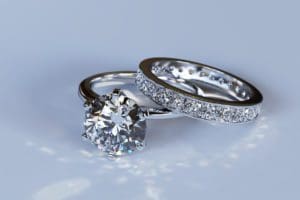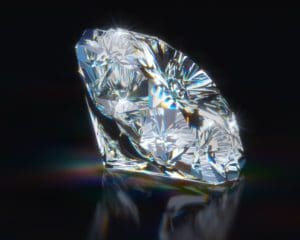A diamond by its very nature is exquisite. The difference between a lab grown diamond vs real diamonds takes some time to understand.
If you are purchasing a diamond for investment, to give as a gift, to hold on to and hand down as an heirloom, it is important to understand the difference between a lab grown diamond and natural diamonds.
Lab Grown vs Natural Diamond
Natural Diamonds
Natural diamonds are mined diamonds, made from pure carbon, and formed far beneath the Earth’s surface under temperature and extreme pressure conditions. They have tiny imperfections. There is no perfect natural diamond.
Diamonds are graded according to the 4Cs; clarity grades, cut, color, and carat weight. The 4Cs are how GIA, the Gemological Institute of America, grades their diamonds.
Diamond Cut
Diamond cut is one of the most important characteristics of the 4Cs. The cut has the greatest effect on a diamond’s beauty. The cut also determines the value of the diamond and how the cutter’s skills enhanced the natural beauty. The fire and sparkle of a diamond are enhanced or subdued by the diamond’s cut.

Diamond Color
There are many colors of diamonds. Blue, clear, red, pink, and more. The color of gem-quality diamonds occurs in many hues, from colorless to light yellow or light brown. Colorless diamonds are the rarest. Some people prefer to own a diamond with a light pink or yellow tint.

Diamond Clarity
The internal characteristics known as inclusions or external characteristics (blemishes) affect a diamond’s clarity. There are no perfectly clear diamonds. Some diamonds have inclusions, and other blemishes, and these can only be seen with magnification. There is a GIA clarity scale for diamonds for grading. A quality diamond has a balance between color and clarity.

Diamond Carat
The carat is the diamond’s physical weight measured in metric carats. One carat equals 1/5 grams and is divided into 100 points. Of the 4cs, carat weight is the most objective. Larger carat weight diamonds are rarer and thus more expensive. A diamond carat is divided into 100 points, meaning a 50-point diamond weighs 0.50 carats. However, a stone with a certain weight may actually look larger than the carat suggests due to its dimensions. Cut can also affect the appearance of a diamond, making it look larger or smaller. A diamond’s weight refers to how much a diamond weighs, not the size of the diamond.
Natural diamonds weigh less than synthetic diamonds of the same shapes.

Lab Grown Diamonds
Lab grown diamonds are grown in labs under strict conditions, similar to those that created natural diamonds. Lab diamonds are started with starter seed diamonds of pure carbon. Whereas, most natural diamonds have trace amounts of other substances, particularly nitrogen.
Seed diamonds are seed crystals in a small chamber filled with carbon rich gas, like methane or other gases. The gases are ionized into plasma using technology similar to microwaves or lasers.
Starter seed diamonds are exposed to temperatures of about 1500 degrees Celsius and pressurized to approximately 1.5 million pounds per square inch. The pure carbon melts and starts to form a pure carbon diamond. Their chemical makeup has no visible difference between a lab grown diamonds and mined diamonds.
Diamonds grown in a lab may have metallic inclusions and weak strain patterns.
Can you tell the difference between a natural diamond and a lab grown diamond with the naked eye?
If you are looking at purchasing a natural diamond or a lab grown diamond, they will look the same to the naked eye. Lab grown diamonds may be clearer, with no inclusions or blemishes.
There are jewelers with years of experience who can’t tell the difference. Man made diamonds are difficult to spot because of their chemical, physical and optical properties similar to their natural counterparts.
Professional jeweler services and pawn shop brokers often have the equipment needed to tell the difference. The testing equipment isn’t cheap to purchase, but if you are buying diamonds regularly and in the business of mounted and loose diamonds, you want to make sure you know the difference.
The physical difference between lab grown diamonds and mined diamonds is very hard to notice. They both look similar when you use the naked eye.
![]()
Axel’s Pawn Shop Has Specialized Equipmen to Test Diamonds
Axel’s Pawn is a family owned and operated pawn shop in Spokane, WA. They have been in business for 30 years, providing trustworthy pawn services. They treat each customer as if they were family.
Diamonds, diamond simulants, fine jewelry, gold and diamond jewelry, and loose stones are all accepted and sold at Axel’s Pawn. Diamond simulants are worth a fraction of the cost of natural diamonds.
Axel’s Pawn has state of the art diamond testing equipment to determine the difference between lab grown diamonds and natural diamonds. This is important when you are concerned about the resale value and the pawn value.
Lab grown diamonds are chemically the same as mined diamonds, but the value is different. When you are considering buying or selling diamonds, knowing what you have is important. The pawn brokers at Axel’s Pawn will use their testing equipment to determine the quality of your diamond, diamond simulants, fine diamond jewelry, and loose diamonds.
If you are on a budget, giving a diamond engagement ring that contains a lab grown diamond might be the thing. But buying a diamond as an investment means you want to make sure the diamond you are considering is not cubic zirconia, a lab created diamond, or a “fake” diamond. You want to buy real, natural stones.
If you have a certificate from the GIA gemological institute, it may bring you more money if you bring it with you.
Axel’s Pawn also accepts luxury handbags, designer watches, and name brand tools if you need fast cash. Stop by and see the today
A diamond by its very nature is exquisite. The difference between a lab grown diamond vs real diamonds takes some time to understand.
If you are purchasing a diamond for investment, to give as a gift, to hold on to and hand down as an heirloom, it is important to understand the difference between a lab grown diamonds and natural diamonds.





Recent Comments